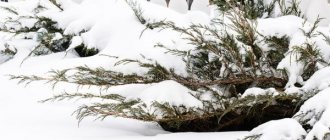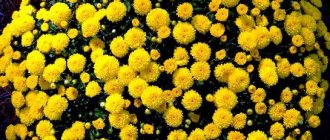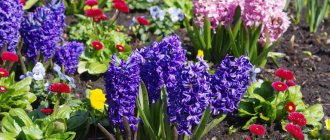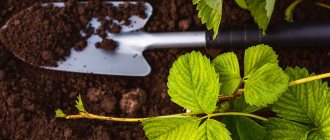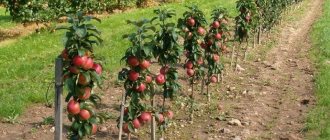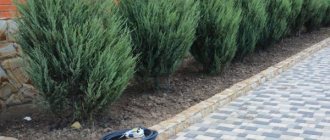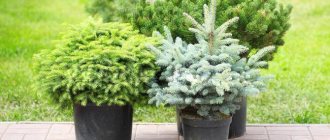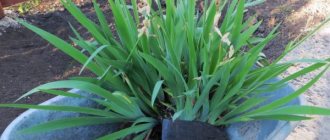Planting in open ground
Planting juniper in open ground requires observing all the nuances - the correct choice of time and place of planting, soil and planting material.
Boarding time
The best time to plant juniper in open ground is early spring.
Moreover, there is no need to wait for warm weather; the plant can be planted immediately after the snow melts.
In later spring, you can also plant young trees, but there is a danger of the needles burning.
When planting juniper in the autumn, there is a possibility that the plant will not have time to take root and acclimatize.
A plant purchased with a closed root system can be planted at any time , even in the hot summer months. True, shading from the sun's rays during the daytime is required.
Selecting a location
Juniper grows well only in open sunny places. Access to sunlight should be available throughout the day. Some shading is allowed only when growing common juniper, but also to a small extent.
The decorativeness of plants, the density of branches and needles depend on the intensity of lighting A juniper growing in the shade will have few branches, they will be random, forming a shapeless loose mass. Variegated needles will lose their original color.
Soil for planting
The soil reaction depends on the type of plant. Alkaline is necessary for common, Central Asian and Cossack juniper. To obtain such a reaction, dolomite flour or slaked lime is added to the soil.
Other species prefer an acidic reaction . This is achieved by adding peat and sand to the soil, mulching using wood shavings and peat.
Siberian juniper requires sandy and sandy loam soil, Virginia juniper requires clay soil, into which it is advisable to add compost.
You need to add drainage from broken bricks, large pebbles and sand to the planting hole The thickness of the drainage layer is about 15-25 cm.
Planting material
It is best to plant young plants growing in containers up to 5 liters. They are easier to plant and take root. Especially if the root system is closed (i.e. the plant is placed in the ground along with a lump of earth).
Planting large plants requires some experience and skill. Such seedlings are grown in the ground; before sale, they are dug up, wrapped in burlap or placed in special containers and plastic bags.
It is not recommended to plant mature plants at all. This is explained by the peculiarity of the root system, which is pivotal and goes deep into the soil. It is almost impossible to dig up a specimen without damaging the main root. This will lead to almost inevitable death of the plant.
try to plant an adult juniper only in winter, when the soil coma is frozen. It has been noticed that the closer to spring the planting is done, the greater the likelihood of plant survival.
Before planting specimens in a hole, they are prepared by generously wetting a lump of earth 2 hours before planting.
How to plant juniper correctly?
To plant, you need to dig a hole. Its dimensions depend on the size of the seedling. For young junipers, a hole is made one meter square. They dig about half a meter deep. In any case, the hole is made 2-3 times larger than the soil clod.
The bottom of the pit is lined with a drainage layer. The remaining space is filled with cultivated soil suitable for each type of juniper. The plant is placed in a hole, being careful not to damage the soil ball and roots. In young seedlings, the root collar should be located at the very surface of the soil, in adult plants it should rise by 6-12 cm .
After planting, the plant is watered with plenty of water. The tree trunk circle is mulched with various materials - peat, pine bark, wood chips, sawdust, crushed cones, pine nut shells. The layer thickness should be 5-10 cm .
If several specimens are planted at once, the correct distance between them should be maintained. For small species it should be at least half a meter. For tall and spreading ones - from 1.5 to 2.5 m .
Planting juniper from the forest
If the rules are followed, such a landing is quite possible. In some cases, it is even more reliable, since you choose the planting material .
You need to replant small young plants that still have a small root system. When you find such a tree, mark the sunny side before digging it up. At home, plant on the same side.
Why spathiphyllum leaves turn yellow - find out from our material.
Read our article on how to use vermiculite for plants.
Is it possible to grow oleander at home? Find out at the link: https://sad-doma.net/houseplants/dekarativnotsvetushhie/uhod-za-oleandrom.html
The seedling is dug up along with a lump of soil , immediately placed in a polyethylene film or burlap, wrapped tightly and tied.
Plant in the garden in the same way as purchased material.
Planting bush species
You can plant such a juniper before it grows in breadth and depth. The root system of mature shrubs is strongly intertwined and grows downwards, deep underground. Therefore, only young specimens that have not reached two years of age are planted.
For gardeners’ recommendations for planting juniper, watch the video:
[youtube https://www.youtube.com/watch?v=ciFkJIkPciM&w=700&h=395]
Choosing a quality seedling
Before planting juniper, you need to choose the right seedlings and buy them from a nursery. Stores located in shopping centers often dig the plant out of the ground and send it for sale the next day. Such seedlings are unsuitable for planting, because their chances of survival are too low.
Most often, planting material is sold in containers. It is recommended to choose seedlings between 2 and 4 years old. This rule guarantees high survival rate.
When buying a plant, you should pay attention to the following points:
- Juniper bushes should have an earthen ball wrapped in burlap.
- New shoots are visible on the surface of the root system.
- The trunk of the seedling has no damage or cracks.
- The ends of the needles should not be dry.
- There are no signs of rot on the young plant.
- The crown has a uniform color, without white and brown spots.
Seedlings with a closed root system quickly adapt to new conditions and begin to grow. Plants with an open root system have almost zero chance of survival, so purchasing them is not recommended.
If you find dry or damaged shoots, you should cut them off immediately. It is also necessary to trim the side branches and the top.
Growing juniper from seeds
Not all types and varieties of plants can be grown from seeds . Ornamental hybrid plants reproduce only by cuttings. Pollination occurs with the wind, so very few full-fledged seeds from which it is possible to grow juniper ripen.
Planting material can be collected from plants two years old, during the period of darkening of the berries , but before this process is completed. Seeds from completely dark fruits “go” to rest and go into “hibernation”, so they take a very long time to germinate.
After collection, the seeds need to be stratified . To do this, take a box and fill it with a moist substrate of peat, sand, moss, into which the seeds are placed. Cover the top with another layer of filler.
For the winter, these boxes are taken outside and remain under the snow for the entire cold season for up to 150 days . In this way, cold stratification is carried out naturally. It is needed to speed up germination. Seeds that have not undergone this procedure will be able to sprout only a year after sowing in the ground.
In May, stratified planting material is removed from the substrate and planted in prepared beds. Further care is no different from other plants. Watering, timely weeding, loosening row spacing. Ready seedlings are planted in permanent places.
When to plant juniper in the fall: optimal timing
Coniferous crops can be planted in autumn, spring, and summer. However, each season has its own characteristics for carrying out the procedure. It’s very easy to decide when to plant juniper! It is enough to study the weather forecast for several weeks in advance and generally know the climatic and temperature characteristics and conditions of the region in which you live.
The optimal time for planting a seedling in the autumn is two to three weeks before the first frost , when the air temperature is between 10-13 degrees Celsius (during the daytime) and at least 5 degrees (at night).
Reproduction by cuttings
can be propagated using this method . Low-growing and common juniper take root most easily.
In the spring, cut off young annual branches from a tree you like, always with a piece of the main plant. The length of the cutting is about a decimeter. the material from needles and place it in a solution that stimulates root formation for a day. After the expiration date, the cuttings are placed in a light substrate (sand, peat or a mixture of both). It is moistened, covered with film or cut plastic bottles and left to take root in a shaded place.
Periodically, the “greenhouse” needs to be opened for ventilation and ensure that the substrate does not dry out. If the situation is favorable, in 30-50 days .
After successful root formation, the cuttings are planted in open ground, having previously prepared the beds. To prevent young plants from freezing, they are covered with spruce or pine branches for the winter.
They are transplanted to a permanent place after 2-3 years .
Planting by seeds
Juniper seeds are taken from mature fruiting crops. When the berries begin to darken. They are subjected to thermal and mechanical processing. Keep in the freezer for several months. They do this so that the shrub can withstand low temperatures. Only then can they be planted in open ground. This process is called stratification.
They do this on their own: take a mixture of peat, moss, and sand about 10 liters. Divided into two parts. First, place one part in a box, sow it with seeds, and fill the second part completely on top. The box is placed outside for the winter so that it is covered with snow. In May you can plant them in the garden. Regularly weed, loosen and water until full-fledged seedlings grow.
Rules of care
Unpretentious and unpretentious juniper does not require much attention. However, by following some rules, you will preserve the beautiful appearance of the plant and ensure a long life .
Watering and feeding
The plant can withstand a long period without watering. However, in hot, dry summers it is recommended to water it at least once a month.
also periodically arrange a shower using a spray bottle or other sprayers. The procedure is carried out every week in the early morning or evening, when the sun is not as active as during the day.
In spring, nitroammophos at the rate of 45 g per square meter. During the summer, you can fertilize juniper with organic or mineral fertilizers no more than once a month. Such fertilizing is carried out if the tree grows slower than expected.
Transfer
It is carried out only in case of emergency, because there is no guarantee that the juniper will take root in the new place.
Juniper absolutely does not like !
If you still decide, prepare the optimal soil . It is best to mix coniferous soil, peat, sand in equal parts. After placing in a new location, water the tree thoroughly.
Pruning and care in winter
The plant itself does not require pruning . All that is necessary is to remove dry branches at any time. However, when forming a beautiful crown, you can cut off excess branches using a sharpened tool.
You cannot cut too many branches at once - the tree may get sick .
Young plants are covered with lutrasil or other similar material in the first couple of years Older plants with a spreading crown are tied with rope or twine to prevent branches from breaking due to snow. You can also periodically shake off the snow from the tree.
Juniper care in spring
When the sun becomes active and the snow slowly melts, a very dangerous period begins for all types of junipers. They may die if measures are not taken.
The sun can literally burn needles that were previously under the snow or simply weaned from the burning rays. To prevent this, it is necessary to shade the plants using burlap, thin cloth or other covering material.
After the snow melts , the covering material is removed, and the tree trunk circle is cleared of fallen leaves and other organic debris. The mulch layer is removed, as it can lead to rotting of the roots. The soil is dug up or loosened. When the soil dries out and the threat of rotting goes away, add a fresh layer of mulch.
Cold period for juniper
To survive the winter, a special protective shelter is created before the first frost. This is important for a young plant, in the first year after planting in the soil. Parchment paper, spunbond (synthetic non-woven material) and cotton fabric are used as such shelter. They wrap everything in two layers, tie it with a rope, leaving 10 cm at the bottom. It is not necessary to put a screen on the young seedling. This coverage is sufficient.
You may be interested in:
How and when is the best time to plant thuja in the fall With the onset of autumn comes a favorable time for planting, including for thuja. Planting thuja in the fall…Read more…
Diseases
Juniper diseases:
- Rust . The needles become dirty orange and then dry out. The reason is that a lot of salts are concentrated in the soil. This can happen if animals choose a tree as a toilet.
- If the needles first turn yellow and then die, it means the plant is suffering from excess moisture. This occurs due to heavy rains or floods, waterlogging due to natural causes, or rising groundwater levels. Lack of moisture in the ground and air manifests itself with the same symptoms.
- Red growths on the trunk and branches . In dry weather they are no more than 0.5 cm, after rain they increase 3 times. The tree was attacked by rust fungi. To get rid of the scourge, it is recommended to promptly remove the affected branches and shoots. Increase the resistance of juniper using immunostimulants and microfertilizers.
- Schutte mushroom attack . At the beginning of the season, last year's needles turn orange or brown, but do not fall off. Subsequently, small black round growths appear on it. The fungus attacks weakened plants in the shade. It especially loves humidity and is not afraid of cold weather. Damaged branches must be immediately cut off and burned, and the juniper should be sprayed with sulfur and copper preparations.
- Drying of branches and bark is caused by various fungi. Because of them, growths form on the tree in the form of red warts and longitudinal wood ulcers. To prevent diseases, copper preparations are used, which are used to treat plants in spring and autumn. All open scratches and cuts are disinfected with copper sulfate.
Preparing a juniper seedling
Before planting a juniper seedling, you need to prepare it. To do this, you should water the soil in the container a day before the procedure. For irrigation, water mixed with fertilizers is used to stimulate root formation. It is recommended to use the drugs Kornevin or Heteroauxin. After soaking, it is recommended to remove dry needles near the base of the bush.
The seedling should be planted immediately after the clod of earth has been removed from the container. It is not allowed to leave an earthen ball with roots in the open air for 15 minutes or more. This negatively affects the condition of the rhizome - it will begin to dry out.
Pests
Juniper is affected by the following pests:
- Aphid . Especially loves young plants with delicate needles. A large number of insects can stop the growth of trees and greatly weaken it. To get rid of parasites, it is necessary to promptly destroy the ants that breed aphids. Trees are sprayed with solutions of insecticides - Fufanon, Aktara, Aktellik, Decis.
- Scale insects . It is easy to recognize the attack of this pest - round brown bumps appear on the needles and young shoots. These are scale insects. Their activity leads to the curvature of young shoots, the death of them and the bark. Hunting belts placed on trunks in the spring are very helpful against them. If the number of parasites is small, they can be removed manually. A massive invasion is destroyed with insecticides - Aktara, Fitoverm, Aktellik.
- Spider mite . Its presence is revealed by many tiny cobwebs gradually covering the affected tree. The mites themselves cannot be seen with the naked eye. To prevent their attacks, plants are periodically bathed in a cold shower - mites do not like humidity. You can destroy pests that have already settled in with the help of acaricides - Vermitek, Fufanon, Actellik, Fitoverma.
Planting and caring for juniper
- Planting: April-May or October.
- Flowering: grown as an ornamental foliage plant.
- Lighting: bright sunlight, for some species - light partial shade.
- Soil: moist, loose, sandy and calcareous soils with a pH of 4.5-7.0.
- Watering: only in extreme heat and drought. Water consumption is from 10 to 20 liters per adult plant.
- Air humidity: during hot periods, it is advisable to spray the plant once a week in the evening.
- Top dressing: in the spring, Nitroammofoska is planted in the tree trunk circle.
- Pruning: only when grown as a hedge. Juniper grows very slowly and recovers poorly.
- Reproduction: bush and tree forms - by seeds and green cuttings, creeping forms - by layering.
- Pests: aphids, scale insects, spider mites, leaf miners.
- Diseases: rust, schutte, alternaria, branch bark nectriosis, branch drying, biatorella cancer.
Read more about growing juniper below.
How often to water and how to fertilize juniper
Growing and planting juniper does not present any particular difficulties. If you follow all the recommendations for planting and care, even the most inexperienced gardener who does not know how to plant juniper will be able to grow this amazing shrub on his plot. Caring for the crop consists of several key points, namely:
- Watering.
- Periodic moistening of foliage.
- Loosening the soil.
- Application of fertilizing.
The question of how often to water juniper must be decided based on the climatic conditions in the growing region. Throughout the entire season, you need to water the juniper only if the weather is very hot, and take no more than 1 bucket of water per seedling. It is recommended to moisten the leaves once every 7 days, especially if an ordinary or Chinese variety of shrub is grown. Several times throughout the season it is necessary to loosen the soil so that a film does not form near the tree trunk, and also to remove weeds.
Watering
How to feed juniper in summer
It is necessary to evenly distribute 40 g of nitroammophoska over the entire area of the ground near the tree trunk. After the fertilizer has been applied to the soil, the standard juniper should be watered abundantly.
Note! If, when planting a plant, land was used that is very poor in useful microelements, the shrub must be fertilized until the growing season ends. The break between feedings should be 4 weeks.
Properties of juniper - harm and benefit
Medicinal properties
Since ancient times, juniper has been considered by doctors as a remedy for all diseases. For medicinal purposes, juniper root and its young shoots are used, but most often the fruits are pine cones.
Juniper roots will help in the treatment of tuberculosis, bronchitis, skin diseases, and stomach ulcers. The use of juniper soothes toothache, swelling, improves heart function, relieves inflammation of bronchial and pulmonary tissue, normalizes blood circulation and blood pressure, and helps with constipation.
A decoction of branches is effective in the treatment of diathesis. In terms of its bactericidal properties, juniper needles are ahead of any other plants. Juniper berries contain carbohydrates, wax, sugars, dyes and tannins, organic acids, vitamins, iron, manganese, copper, aluminum and essential oil, which has a choleretic, antimicrobial, diuretic and expectorant effect.
Baths are taken with a decoction of juniper berries for gout and rheumatism; it is applied in the form of compresses to inflamed joints. When taken orally, the decoction improves appetite and digestion, increases the secretion of bile and accelerates intestinal motility.
Recipe for berry decoction: crush 1 tablespoon of berries, pour a glass of boiling water, cook for 10 minutes, leave for half an hour, strain.
Contraindications
It is not recommended to take preparations from juniper during pregnancy, severe hypertension, acute kidney inflammation and individual intolerance.
Types and varieties
Juniper is so in demand in landscape design that breeders tirelessly develop more and more new forms and varieties of this plant, despite the fact that many natural species of juniper are grown in cultivation. We offer you an introduction to the most popular cultivated species, forms and varieties of juniper, among which you will surely find a plant that will decorate your garden.
- Erantis: growing from seeds, types and varieties
Common juniper (Juniperus communis)
It is a tree or shrub ranging from 5 to 10 m in height with a trunk diameter of up to 20 cm and with a dense cone-shaped crown in tree-like forms and ovoid in shrubs. Its bark is fibrous, gray-brown, and its shoots are red-brown. The needles are green, needle-shaped, pointed, triangular; needles up to 1.5 cm long remain on the branches for up to 4 years. It blooms in May with yellow male flowers and green female flowers. Lives up to 200 years. Round cones up to 1 cm in diameter are green when immature, blue-black with a waxy coating when mature.
Varieties of common juniper:
- Depressa (pressed) is a wide-flat creeping form up to 1 m high with wider and shorter needles than the main species;
- Montana is also a creeping juniper up to 20 cm high with short, thick triangular branches;
- juniper Green Carpet is a creeping dwarf shrub with a flat crown and light green soft needles, in ten years it grows no more than 10 cm in height with a crown diameter of 1.5 m;
- Columnaris is a columnar form of common juniper with a blunt top up to one and a half meters high and up to 30 cm wide. The shoots are ascending, covered with short needles, bluish-green below, with a bluish-white stripe above.
In addition to those described, many more forms and varieties of this species are known: Horstmann, Erecta, Nana Aurea, Meyer, Pyramidalis, Repanda, Sentinel and many, many others.
Virginia juniper (Juniperus virginiana)
Or “pencil tree” - evergreen trees up to 30 m high with a narrow ovoid crown in youth, which over time becomes prostrate due to widely spaced branches. The trunk diameter sometimes reaches 150 cm. The bark is dark brown or red-brown, flaking, green in young shoots. The needles are small, needle-shaped or scaly, dark green in color. Juniper virginiana berries are spherical in shape, dark blue in color with a bluish bloom, up to 6 mm in diameter. In culture since 1664.
The most popular cultivars of this species:
- Blue Arrow juniper has columnar, pin-shaped and bushy forms. Among them are Gray Ole, Glauka and Boskop Purple with gray-blue needles, Robusta Green and Festigiata with bluish-green needles, Canaertii with dark green, Silver Sprider with silver-green needles.
Juniper horizontal, or prostrate (Juniperus horizontalis)
It grows naturally in the USA and Canada on the sandy shores of lakes and rivers, in the mountains and on hillsides. This is a creeping juniper up to 1 m high with long branches on which tetrahedral blue-green shoots are densely located. Gray or green needles tend to turn brown in winter. Blue-black fruits of horizontal juniper with a bluish bloom, up to 9 mm in diameter. The species has been in cultivation since 1840.
Shapes that attract the attention of gardeners:
- Andorra Compacta is a cultivar 30-40 cm high with a cushion-shaped crown with a diameter of about a meter. The branches rise obliquely, the needles are small, scaly, purple in winter and gray-green in other seasons;
- Plumosa, or Andorra Jupiter , is a creeping shrub up to 50 cm high and up to 2.5 m wide with branches and feather-like branches lying on the ground with awl-shaped needles of a purple hue in winter and light gray-green at other times;
- Prince of Wales is a creeping shrub up to 30 cm high and a crown diameter of up to 2.5 m with brown bark, reddish dense needles in winter and bluish in any other time.
Cossack juniper (Juniperus sabina)
Creeping shrub up to 1.5 m high, quickly growing in width and forming dense thickets. Sometimes there are tree-like forms with curved trunks up to 4 m in height. The blue-green needles of this species are of two types: in adult plants they are scale-like, in young plants they are needle-shaped. A characteristic feature of plants of this species is the pungent odor of shoots and needles when rubbed, since they contain poisonous sabinol essential oil.
In culture since 1584. The most famous forms:
- Capressifolia is a low-growing shrub up to 50 cm high with a wide crown, outstretched shoots extending from the base of the bush and rising upward. The needles are greenish-blue, scaly, and needle-shaped needles are found in the lower part of the crown;
- Femina is a shrub up to 1.5 m high and a crown diameter of up to 5 m. The bark is reddish-brown, on the shoots it is dark green. The scaly, poisonous needles with an unpleasant odor are also dark green;
- Mas - bush height 1.5-2 m, crown diameter sometimes reaches 8 m, bark reddish-gray. The needle-like, prickly needles are green below and gray on the upper side.
Chinese juniper (Juniperus chinensis)
It is a tree 8-10 m high with a pyramidal crown, but in some cases it is a shrub pressed to the ground or spread out. The bark is peeling, reddish-gray, the shoots are dark green, the leaves are scaly, although needle-like, prickly needles can be seen on young plants or in the lower part of the crown.
Popular varieties in cultivation:
- juniper Stricta is a narrow-pointed plant, very branched, the branches are raised and evenly spaced. The shoots are short, straight, the needle-shaped needles are greenish-blue on the upper side, as if covered with frost on the lower side. In winter, the needles take on a gray-yellow hue;
- Olympia is a narrow columnar-shaped plant with raised branches, short branches and needles of two types: needle-shaped greenish-blue and bluish scaly;
- Japonica is a dwarf-shaped juniper, sometimes pin-shaped up to 2 m tall, sometimes creeping. The branches are short and dense, sharp, prickly, scaly leaves are light green in color;
- Gold Coast juniper is a shrub up to 1 m high and a crown diameter of about 3 m with golden-yellow needles that darken with the onset of autumn.
Rock juniper (Juniperus scopulorum)
Native to North America. This is a tree up to 18 m high or a shrub. The spherical crown of rock juniper plants starts almost from the base. Young shoots are about 1.5 cm thick and greenish-blue or light green in color. The needles are predominantly scaly, but there are also plants with needle-shaped leaves. The fruits are dark blue with a bluish tinge.
Varieties:
- Repens is a creeping shrub with feather-like branches directed upward on low-creeping branches. Needle-shaped leaves up to 5 mm long, blue on the upper side, greenish-blue on the lower side;
- Springbank is a narrow pin-shaped plant up to 2 m high with flexible and spaced upper branches and almost thread-like ends of the shoots. The needles are silver-blue, scaly;
- Skyrocket is a tall Dutch cultivar with a narrow habit, reaching a height of 10 m by the age of three. The shoots are straight, the needles are gray-green.
Scaly juniper (Juniperus squamata)
A very variable species of evergreen shrub up to 1.5 m high. The bark is dark brown, the needles are sharp, hard, lanceolate, dark green on the underside and white on top due to stomatal stripes. The cone berries are black. In culture since 1824.
The most famous varieties:
- Blue Star juniper is a Dutch dwarf cultivar up to 1 m high with a semicircular dense crown up to 2 m in diameter. The needles are bluish-white, it looks especially impressive in late May and early summer;
- Meyeri is a well-known decorative form of shrub, densely branching when young, and reaching 2 to 5 m in height when mature. The color of the needles is white-blue, very impressive;
- Rodery is an erect shrub up to 1.5 m high with a dense pin-shaped form. The leaves are short and sharp, needle-shaped, blue on the upper side and green on the lower side.
Juniper medium (Juniperus x media)
A hybrid between Cossack and Chinese junipers, which is a shrub with arched shoots with drooping ends and two types of needles: scaly, and in the thick of the crown, needle-shaped. During the growth period, the needles are light green in color, then become darker. Large specimens can reach a height of 3 m and a width of 5 m.
The most famous variety:
- Mint Julep is a fast-growing spreading shrub with a wavy crown, reaching 1.5 m in height and 3 m in diameter by 10 years. Due to its large size it is used for large parks and gardens.
In addition to the described types of juniper, in cultivation there are Dahurian, recumbent or leaning, false Cossack, oblong, Sargent, Siberian, hard, Turkestan and other types of junipers, as well as their numerous forms and varieties.
How to propagate juniper
There are several ways:
- propagation by layering (applicable only to creeping varieties),
- seeds,
- cuttings.
The most popular method of propagation is by cuttings; step-by-step instructions will be presented below.
Juniper cuttings
Cuttings should be prepared in the spring by cutting small shoots that are already woody. The length of the cuttings must be at least 5 cm, they must necessarily have an internode and a “heel”. For these purposes, cutting cuttings is highly not recommended; you need to tear them off with your hands so that the parent plant remains at the end, or rather, a piece of its bark. The next step is to treat the cuttings with a substance that will stimulate active growth of the root system.
It is necessary to plant cuttings following the 7*7 pattern in a mixture of soil, for the preparation of which you will need peat or humus, as well as sand. After the planting material has been planted, it must be covered with a glass jar on top for protective purposes.
Note! Before autumn arrives, the seedlings will be completely rooted in the ground, but transplanting to a permanent bed is possible only after 2 years.
Toxic substances of juniper
Most types of juniper contain toxic substances that affect the central nervous system, digestive tract, kidneys and more. For this reason, it is not advisable to plant juniper where there are children or pets, since both of them are able to taste a plant unknown to them. And the berries of one of the species of this evergreen shrub - Cossack juniper - even contain poison.
Most types of juniper are planted on the site solely for decorative purposes.
Juniper in landscape design
Junipers can be seen in a suburban area either as single plants or in small groups. As a rule, these are several bushes. The plant is rarely used as a hedge. The reason here is slow growth and high price. However, gardeners love to plant this conifer and decorate their landscape with it. The thing is that junipers have a variety of spreading and creeping crowns, which look very beautiful on the site.
To date, varieties of junipers of different colors have been bred. In addition to emerald and soft green, this conifer can be blue and yellow. These colors fit very organically into the garden design. Also, this evergreen plant can combine several colors, for example, blue and yellow.
Ground cover and creeping varieties of juniper are excellent for decorating a rock garden, alpine hill or slope on the site of a country house.
Juniper can live up to 1000 years and even longer, everything will depend on proper care and planting of this plant in open ground. Planted with love and care, this conifer will respond in kind: it will delight you with its beautiful appearance and aroma.
You can purchase juniper seedlings for landscape design or hedges in this section.

